西准噶尔冬别列克断裂晚第四纪以来的阶地位错与滑动速率
【类型】期刊
【作者】姚远,李帅,黄帅堂,贾海梁(新疆维吾尔自治区地震局;中国地震局地质研究所地震动力学国家重点实验室;西安科技大学建筑与土木工程学院)
【作者单位】新疆维吾尔自治区地震局;中国地震局地质研究所地震动力学国家重点实验室;西安科技大学建筑与土木工程学院
【刊名】地震地质
【关键词】 西准噶尔;冬别列克断裂;阶地位错;滑动速率
【资助项】中国地震局地震科技星火计划项目(XH17042Y);新疆地震科学基金课题(201810);国家自然科学基金(41702334)共同资助
【ISSN号】0253-4967
【页码】P803-820
【年份】2019
【期号】第4期
【期刊卷】1;|6;|7;|8;|2
【摘要】冬别列克断裂是一条全新世活动断裂,位于西准噶尔造山带的关键位置,该断裂总长120km,走向NE。晚第四纪以来,冬别列克断裂的持续活动使得断裂沿线各级地貌面发生了明显的左旋位错,在塔城盆地东侧形成线性连续且笔直的陡坎地貌。文中利用高精度无人机和差分GPS对阿合别斗河多级阶地的左旋位错量进行了面状航拍、测量,建立了分辨率高达0. 1m的数字地形数据,发现T5—T2阶地陡坎的最大左旋位错量依次为30. 7m、12. 0m和8. 7m。通过光释光测年方法得到了各级阶地(T5—T1)的年龄,进而得出冬别列克断裂晚更新世以来的左旋滑动速率为0. 7~0. 94mm/a,结合阶地侧向侵蚀特征,分析认为T4、T2阶地的滑动速率更加接近真实值(0. 91±0. 18) mm/a。结合西准噶尔的其它2条大型走滑断裂(达尔布特断裂和托里断裂)的滑动速率,并对比西准噶尔地区的GPS速率,认为该地区NE向的走滑运动以冬别列克断裂为主,吸收大量剩余变形,同时保持相对较高的左旋滑动速率。
【全文】 文献传递
西准噶尔冬别列克断裂晚第四纪以来的阶地位错与滑动速率
0 引言
走滑断层在亚洲新生代以来的构造变形过程中起到了重要的作用(Molnar et al., 1975), 其在成山过程和大陆变形过程中的作用一直是地球科学界普遍关心的重要问题。 不少研究者认为走滑断层最重要的作用之一是调节不同刚性地块之间的相对运动(Tapponnier et al., 1982, 2001; Peltzer et al., 1988, 1989; Replumaz et al., 2003; Me′riaux et al., 2004), 由于刚性地块内部不发生或只发生很小的构造变形, 刚性地块间的差异运动主要发生在其边界的走滑断层上, 因此走滑断层往往具有很高的滑动速率。
如何确定断层的滑动速率在时间和空间上的变化程度是活动构造研究的一个基本问题, 其对于走滑断层的研究尤为重要, 而精确的地貌面年代测定和断层地貌的位移测量为得到断层的滑动速率提供了观测基础, 水平走滑运动使河流阶地产生的横向偏移为研究走滑断层的滑动速率和活动期次提供了地貌标志(Lensen, 1968; Weldon et al., 1985; Berryman, 1990; Van et al., 1998; Prentice et al., 2003; Me′riaux et al., 2004; Rihanna, 2005; Cowgill, 2007; Harkins et al., 2008)。 同时, 断裂的滑动速率是研究地球动力学的重要基础资料。青藏高原北缘一系列的大型走滑断裂, 如阿尔金断裂、 冷龙岭断裂和海原断裂等控制着青藏高原晚新生代的构造变形及强震的发生, 在检验青藏高原变形理论时, 断裂的滑动速率是一个重要的定量参数(Peltzer et al., 1988; Avouac et al., 1993; Tapponnier et al., 2001; England et al., 2005)。
目前, 全新世以来断裂的滑动速率主要通过各级地貌面相应的滑移量与地貌面年代的比值来限定。 在河流的演化过程中, 河流阶地出现陡坎的现象非常常见, 其显著的线性特征常被用于恢复水平位错之前的形态和位置, 进而可准确确定水平位错量。 同时, 阶地的废弃年代也较易测得, 因此常被用于计算走滑断裂的长期和平均滑动速率(Weldon et al., 1985; Sieh, 1996; Gold et al., 2009)。 本文对冬别列克断裂左旋断错的河流阶地进行测量, 并结合光释光测年方法, 计算出冬别列克断裂晚第四纪以来的滑动速率, 为分析、 讨论其在准噶尔盆地形成、 演化过程中的响应提供依据。
1 地质构造背景
准噶尔盆地位于中亚腹地(图1a), 盆地基底表现为刚性块体(曲国胜等, 2008a), 经历了从古生代到新生代的多期构造活动(郭召杰等, 2006; 李锦轶等, 2006; 肖文交等, 2008)。 其中, 发生在新生代晚期的印度板块与欧亚大陆碰撞的远程效应导致本区出现强烈的构造变形(Burchfiel et al., 1989)。 盆地在平面上近似呈正梯形(图1a), 周缘被几组大型断裂所控制(Allen et al., 1997; 曲国胜等, 2008b), 其南部为北天山山前推覆构造带(冯先岳; 1985; 杨晓平等, 1998, 2008; Yin et al., 1998; 邓起东等, 1999), 东部为富蕴右旋走滑断裂带(新疆维吾尔自治区地震局, 1985; Lin et al., 1998; 徐锡伟等, 2012), 北部为额尔齐斯河断裂(柏美祥, 1996), 西侧为冬别列克(杨庚等, 2011; 罗福忠等, 2015; 姚远等, 2015)、 达尔布特(赵瑞斌等, 1997)等一系列大型左旋走滑断裂, 这些断裂控制着盆地内及周缘强震的发生, 如1906年玛纳斯8.0级地震、 1931年8月11日富蕴8.0级地震和1957年戈壁阿尔泰8.3级地震等。 与大构造背景不协调的是准噶尔盆地西缘的一系列左旋走滑断裂上没有任何强震被记录下来, 这一系列左旋走滑断裂与富蕴右旋走滑断裂构成了一组共轭剪切断裂系。 晚第四纪以来富蕴断裂带保持较高的右旋滑动速率(约1mm/a)(徐锡伟等, 2012), 而西缘的左旋走滑断裂是否存在与之对应的水平滑动速率?作为准噶尔盆地西缘左旋走滑断裂系断层活动遗迹最为清晰的冬别列克断裂是研究该问题的理想对象。
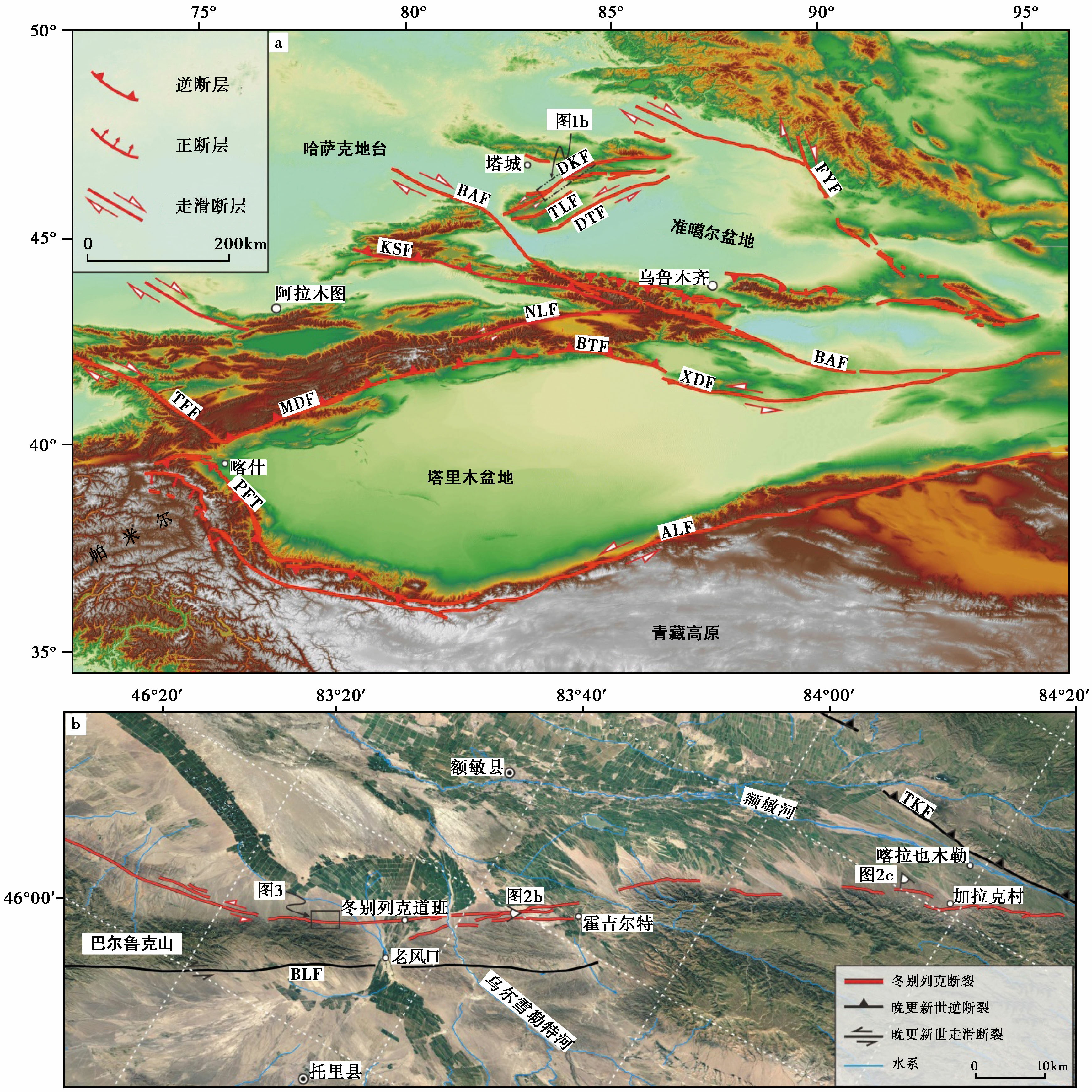
图 1 新疆及周边地区主要活动构造分布(a)及冬别列克断裂卫星影像解译图像(b)
Fig. 1 Distribution of major active faults in Xinjiang and its surrounding area(a), and satellite image interpretation of the Dongbielieke Fault(b).
DKF 冬别列克断裂; TLF 托里断裂; BLF 巴尔鲁克断裂; DTF 达尔布特断裂; TKF 塔克台断裂; BAF 博-阿断裂; FYF 富蕴断裂; KSF 喀什河(伊犁盆地北缘)断裂; NLF 那拉提断裂; XDF 兴地断裂; BTF 北轮台断裂; MDF 迈丹断裂; TFF 塔拉斯-费尔干纳断裂; PFT 帕米尔前缘逆冲推覆系; ALF 阿尔金断裂
冬别列克断裂北起额敏县喀拉也木勒乡, 向SW延伸, 经加拉克村、 冬别列克道班、 老风口, 南至巴尔鲁克山北麓, 在卫星影像上呈现出非常清晰的线性特征, 整体走向约46°, 总长约120km。 根据走向、 运动性质等的不同, 断裂可分为北、 中、 南3段(图1b)。 北段(喀拉也木勒—霍吉尔特)倾向NW, 为左旋走滑兼正断性质, 断层断错晚第四纪以来的山前洪积台地, 保留清晰的断层三角面(图2c), 总长约60km。 中段(霍吉尔特—老风口)切割低山丘陵区, 走向为35°~46°, 断层陡坎最高约1m, 总长约30km, 沿断裂分布有拉分盆地(图2b)、 挤压鼓包及线状分布的植被, 断层陡坎构成了全新世沼泽地与戈壁滩角砾层的分界线, 沿线分布有多口泉水。 南段(老风口以南)倾向SE, 以左旋走滑为主, 兼具一定的逆冲分量, 总长约30km, 在该段洪积扇上的冲沟内发现断错痕迹, 断裂逆冲断错了洪积扇面, 将下伏基岩逆冲至砾石层之上(图2d), 断层带宽2~3m。
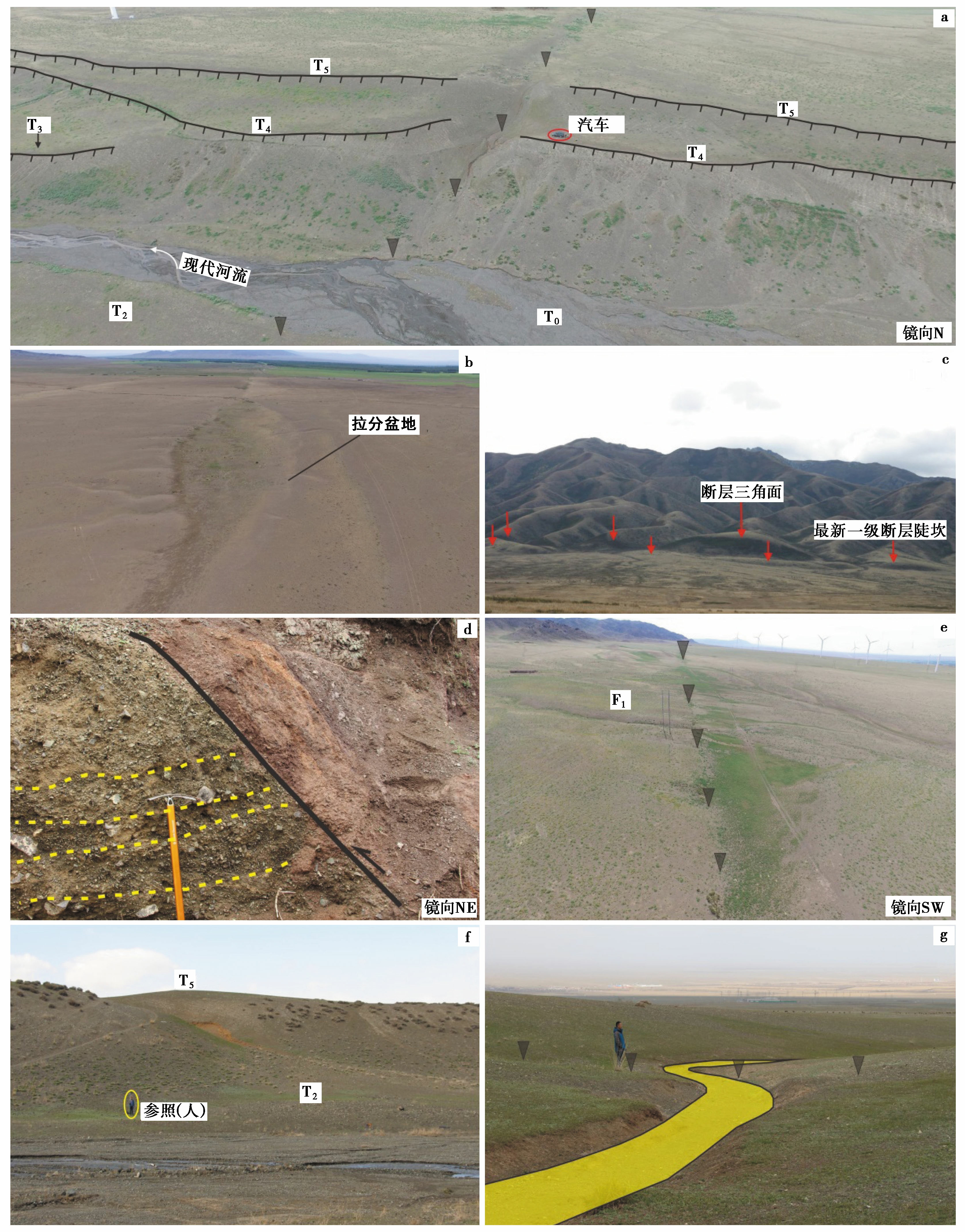
图 2 冬别列克断裂野外活动构造照片
Fig. 2 Field pictures showing the fault activity along the Dongbielieke Fault.
a 阿合别斗河右岸断层断错阶地特征; b 断裂中段拉分盆地特征; c 断裂北段山前台地被断错形成的断层三角面; d 冲沟揭露出断裂剖面; e 无人机拍摄的断裂展布特征; f 阿合别斗河T2、 T5阶地的垂直分布特征; g F1洪积扇面上被左旋断错的纹沟
本次工作主要聚焦于冬别列克断裂南段(图1b), 通过建立高分辨率的数字高程模型(DEM), 对阿合别斗河两岸的阶地、 洪积扇近2km线性良好的断错地貌进行了细致的活动构造解译, 获得断层不同期次的左旋走滑位移量, 结合河流相沉积物的光释光测年数据确定被断错地貌面的沉积年龄, 并计算得到冬别列克断裂晚第四纪以来的走滑速率。
2 冬别列克断裂的断错地貌
2.1 阶地发育特征
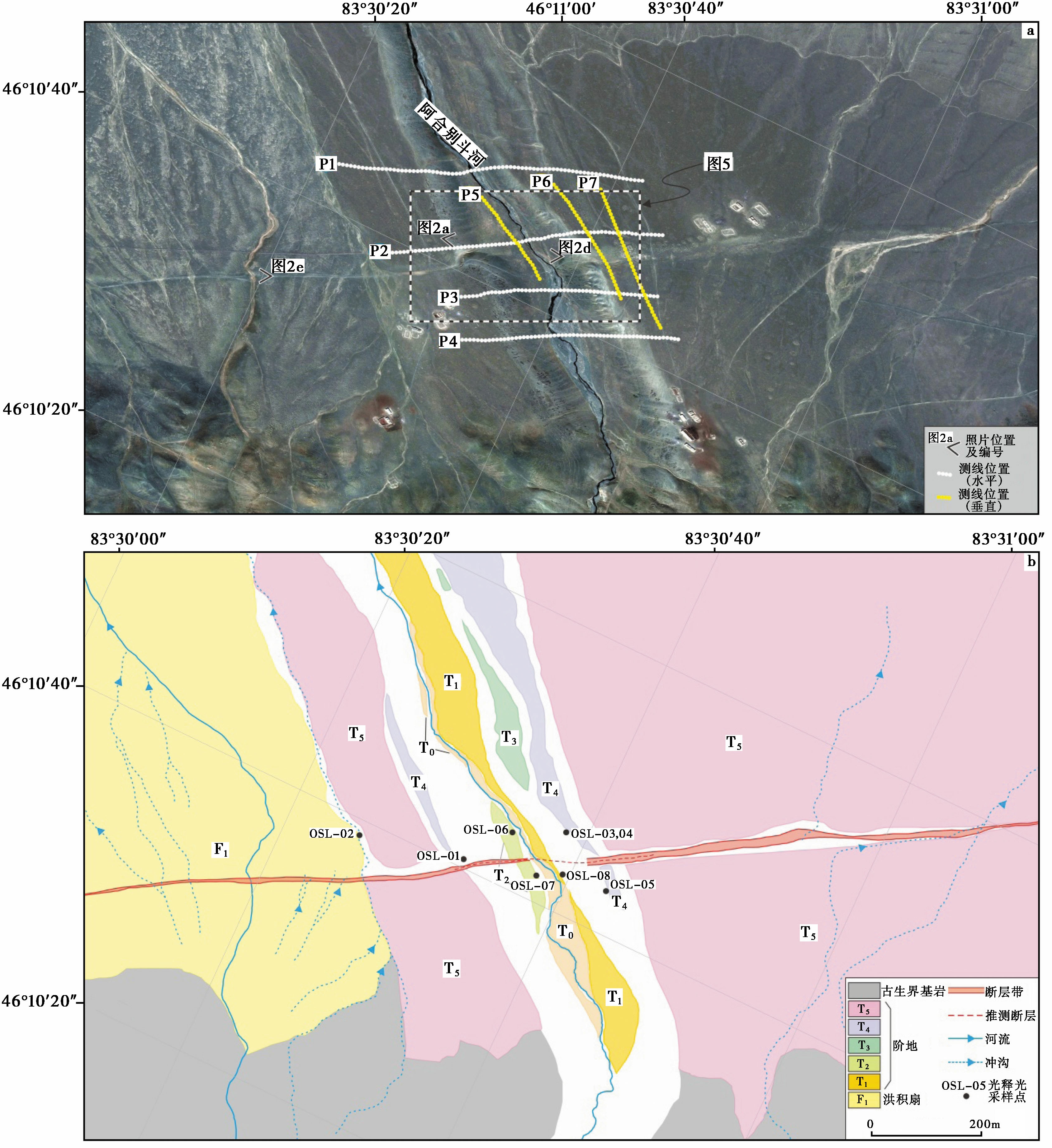
图 3 冬别列克断裂南段卫星影像和断错地貌解译图
Fig. 3 Satellite image(a)and offset landforms interpretation(b)of the southern Dongbielieke Fault.
a Google Earth影像及测线布置; b影像解译图
在老风口以西约4km处(46.18°N, 83.51°E), 断裂活动使阿合别斗河的多级阶地发生了水平和垂直断错(图3)。 根据拔河高度可将河流阶地划分为5级。 其中, 河西岸仅发育2级阶地(T5和T2), 阶地陡坎坡度较大; 而河东岸则保存4级阶地(T5、 T4、 T3和T1), 阶地陡坎呈缓坡状(图4a)。
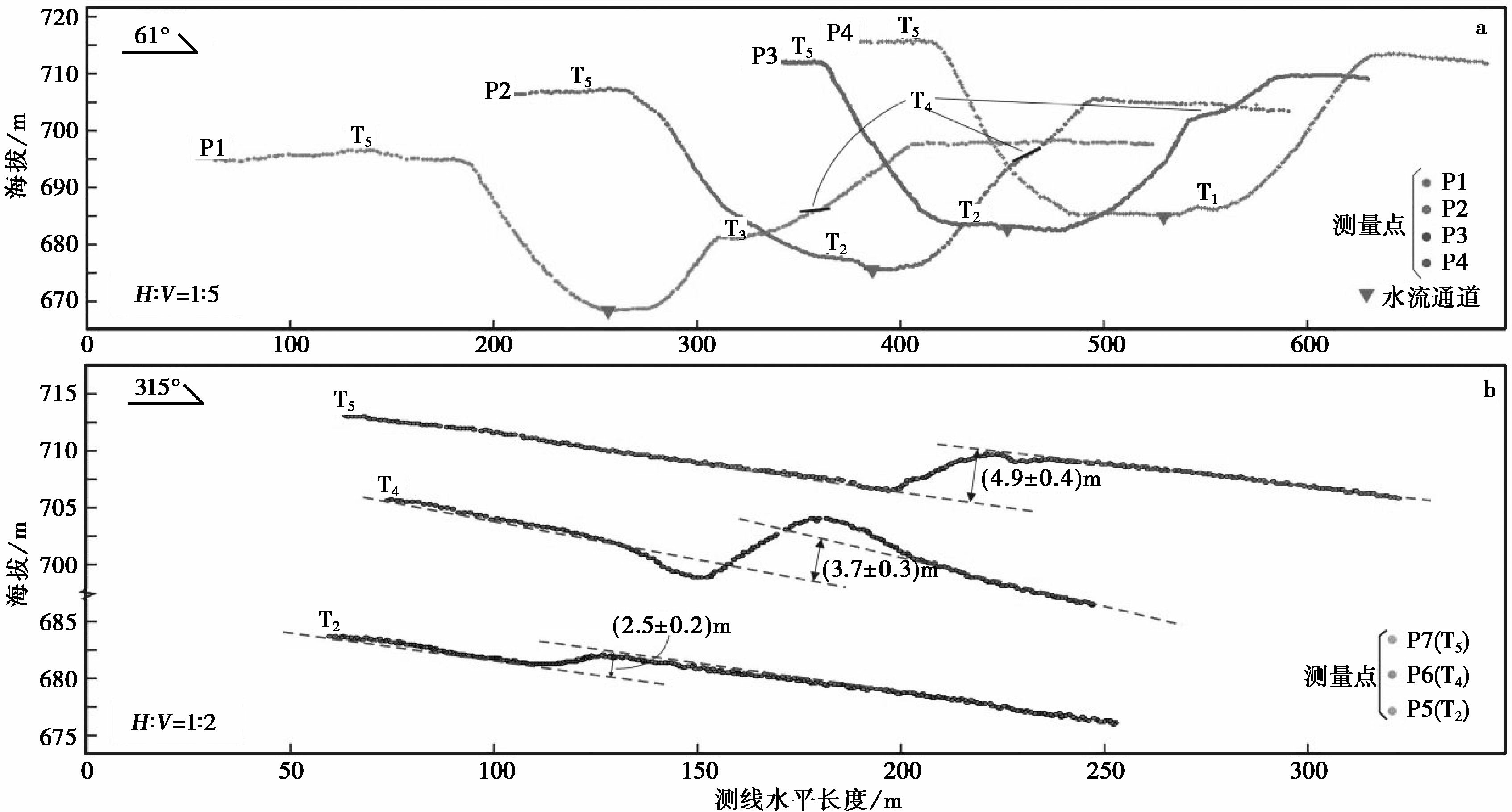
图 4 冬别列克断裂南段阿合别斗河阶地、 断层陡坎地形剖面
Fig. 4 Topographic profiles of terraces of Ahebiedou River(a)and fault scarps(b)in the southern Dongbielieke Fault.
a 阿合别斗河阶地横向剖面; b 各级阶地面上断层陡坎地形剖面
T5阶地拔河高度为27m, 表面冲沟发育, 为研究区内面积最大的1级地貌面(图2a), F1扇是叠加在T5阶地上的洪积扇, T5阶地上部堆积磨圆较好、 粒径为5~10cm的砾石层, 下部由厚达2~3m的次生黄土组成(图2f)。 T4—T1是下切T5阶地后形成的阶地, 其中T4阶地广泛分布于河流右岸, 拔河高度为15m, 地表以下分布着厚约2m的次生黄土(图3, 图2a)。 T3仅在断层北盘分布, 面积较小, 拔河高度为10m; T2阶地分布于河流左岸, 拔河高度为3m, 表层覆盖棱角状砾石, 粒径为5~15cm, 大者可达30~40cm, 下部为粉土、 砂与砾石互层(图2f); T1阶地沿河流两岸分布, 未发现错动痕迹。
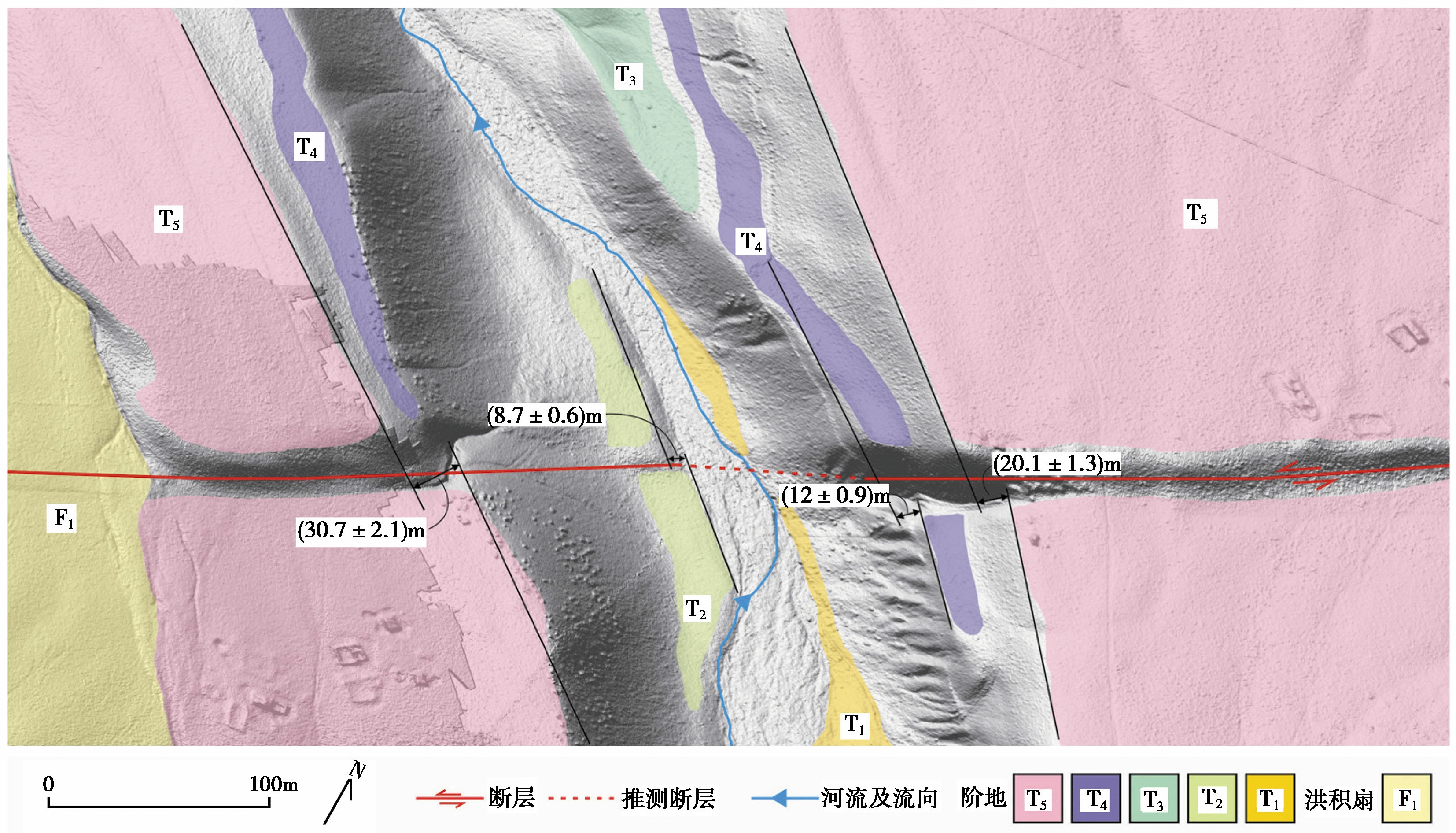
图 5 高分辨率阿合别斗河断裂断错地貌影像
Fig. 5 High-resolution satellite image of the offset landforms on the Ahebiedou River Fault.
2.2 地貌面年龄
冬别列克断裂地处塔城盆地东缘, 夏季降雨、 冬季降雪较多, 地表被植被覆盖, 表层存在较厚层的黄土、 粉砂层, 该类地层中的石英、 长石等矿物信号晒退较快、 较好, 比较适宜采用光释光(OSL)方法进行测年。 在各级地貌面上带有沉积水平层理的粉砂、 细砂中, 令不锈钢套管(长20~30cm)平行于沉积层并以敲击的方式采集光释光测年样品(图6), 套管两头用黑色塑料袋做避光处理, 外部用胶带包裹锡纸, 完全隔绝光线的二次照射。
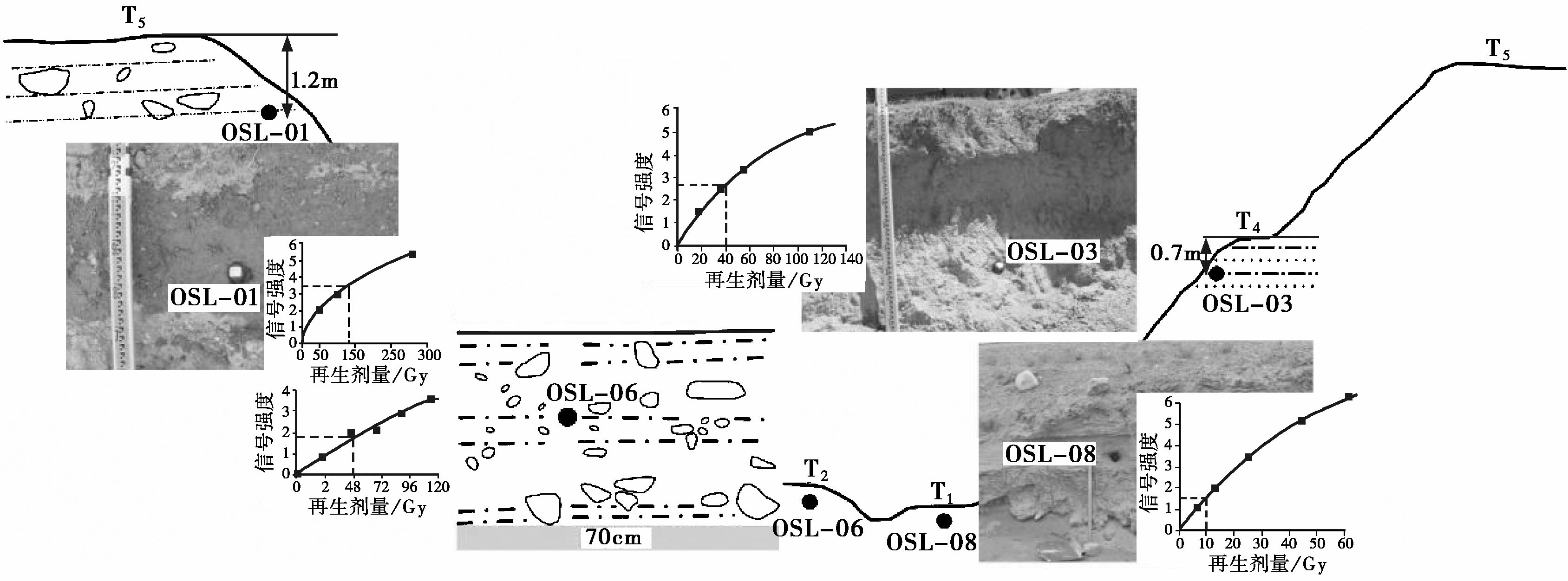
图 6 冬别列克断裂年代样品采集点及数据
Fig. 6 The dating sampling sites and data of the Dongbielieke Fault.
本文中光释光样品的处理在防灾科技学院新构造年代学释光测年实验室完成, 样品均为粉砂或粉土, 故采取4~11μm细颗粒石英简单多片再生法进行测试。
分析已测得的光释光年龄数据(表1)可知, T5阶地2个有效的年龄数据分别为(45.6±3.5)ka和(44.1±5.21)ka, 由此估计T5阶地被废弃形成的年龄为44.85ka; T4阶地主要发育在河流的右岸, 得到其3组光释光年龄数据, 分别为(13.0±1.5)ka、 (14.6±1.8)ka和(13.72±1.9)ka, 估计该地貌面被废弃的平均年龄为13.77ka; T2阶地局限于河流的左岸, 在该地貌面采集到2组光释光样品, 年龄分别为(9.4±1.2)ka和(9.6±1.5)ka, 故该地貌面被废弃的平均年龄为9.5ka; T1阶地为最新1级阶地, 在其下部0.4m深的粉砂透镜条带采集了光释光样品, 测得的年龄为(2.7±0.2)ka。
表1 冬别列克断裂沉积物光释光年龄测定值
Table 1 The OSL dating results of the deposits on the Dongbielieke Fault
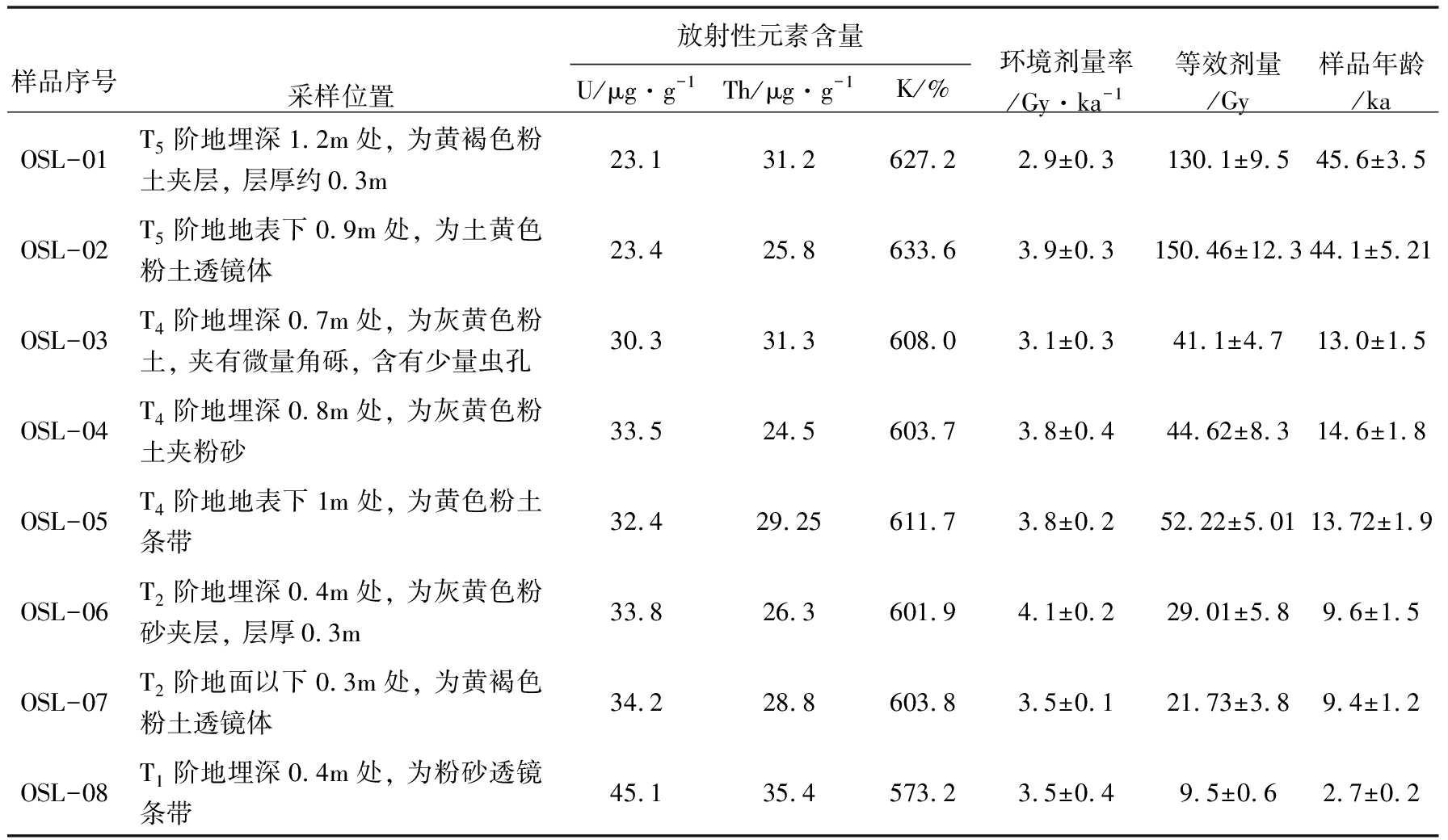
样品序号采样位置放射性元素含量环境剂量率/Gy·ka-1等效剂量/Gy样品年龄/kaU/μg·g-1Th/μg·g-1K/%OSL-01T5阶地埋深1.2m处, 为黄褐色粉土夹层, 层厚约0.3m23.131.2627.22.9±0.3130.1±9.545.6±3.5OSL-02T5阶地地表下0.9m处, 为土黄色粉土透镜体23.425.8633.63.9±0.3150.46±12.344.1±5.21OSL-03T4阶地埋深0.7m处, 为灰黄色粉土, 夹有微量角砾, 含有少量虫孔30.331.3608.03.1±0.341.1±4.713.0±1.5OSL-04T4阶地埋深0.8m处, 为灰黄色粉土夹粉砂33.524.5603.73.8±0.444.62±8.314.6±1.8OSL-05T4阶地地表下1m处, 为黄色粉土条带32.429.25611.73.8±0.252.22±5.0113.72±1.9OSL-06T2阶地埋深0.4m处, 为灰黄色粉砂夹层, 层厚0.3m33.826.3601.94.1±0.229.01±5.89.6±1.5OSL-07T2阶地面以下0.3m处, 为黄褐色粉土透镜体34.228.8603.83.5±0.121.73±3.89.4±1.2OSL-08T1阶地埋深0.4m处, 为粉砂透镜条带45.135.4573.23.5±0.49.5±0.62.7±0.2
2.3 地貌面断错特征
在构造地质学范畴内, 河床、 阶地陡坎、 冲洪积扇以及山脊等断错地貌现象都是地震在地表留下的活动遗迹(Sieh, 1996), 现今高分辨遥感技术的发展, 尤其是高分辨率无人机摄影、 测量技术的发展和应用, 明显提高了活动断层断错地貌影像的空间分辨率, 减小了断裂滑动速率因测量导致的误差(Zielke et al., 2010)。
为得到冬别列克断裂更加准确的左旋走滑位移量和不同地貌面累积的左旋走滑位移量, 本文选择断裂南段的阿合别斗河(图3, 图2a)作为测量对象, 利用微型旋翼无人机(DJI Inspire 1)对其进行三维拍照, 获得了该区域分辨率可达10cm的数字地形高程数据(DEM), 据此恢复、 重建了不同地质体、 地貌面(线)形成以来的左旋走滑位移量。 其中, T5阶地最大左旋位移量为(30.7±2.1)m, 最小左旋位移量为(20.1±1.3)m; T4阶地左旋位移量为(12±0.9)m; T2阶地左旋位错量为(8.7±0.6)m(图5)。 T5、 T4和T2上断层陡坎的高度依次为(4.9±0.4)m、 (3.7±0.3)m和(2.5±0.2)m(图4)。
将阿合别斗河的高分辨率数字高程影像数据打断并复原(图7), 得到各级阶地所累积的左旋位错量。 对断错阶地图像进行打断处理, 并恢复了3个阶段(即Ⅰ与Ⅱ、Ⅲ、Ⅳ这3个阶段, 其中Ⅰ与Ⅱ为T5阶地西岸与东岸所保留的左旋位错量)。 Ⅰ为T5阶地左旋位错量的最大值(图7a), Ⅱ为T5阶地左旋位错量的最小值(图7b); Ⅲ为T4阶地的左旋位错量; Ⅳ为T2阶地恢复得到的左旋位错量。 通过T5阶地西岸的位错量(30.7±2.1)m和最大年龄(44.85±4.3)ka得到该地貌面的滑动速率为(0.70±0.11)mm/a; 同样, 通过东岸位错量(20.1±1.3)m与T5阶地年龄(44.85±4.3)ka得到滑动速率为(0.46±0.08)mm/a。 T4阶地仅在河流东岸被完整地保留, 重新恢复其阶地陡坎, 得到T4阶地的位错量为(12±0.9)m(图7c), 地貌面年龄为(13.77±1.6)ka, 故其滑动速率为(0.89±0.17)mm/a。 T2阶地的左旋位错量为(8.7±0.6)m(图7d), 地貌面年龄为(9.5±1.35)ka, 故其滑动速率为(0.94±0.2)mm/a(表2)。
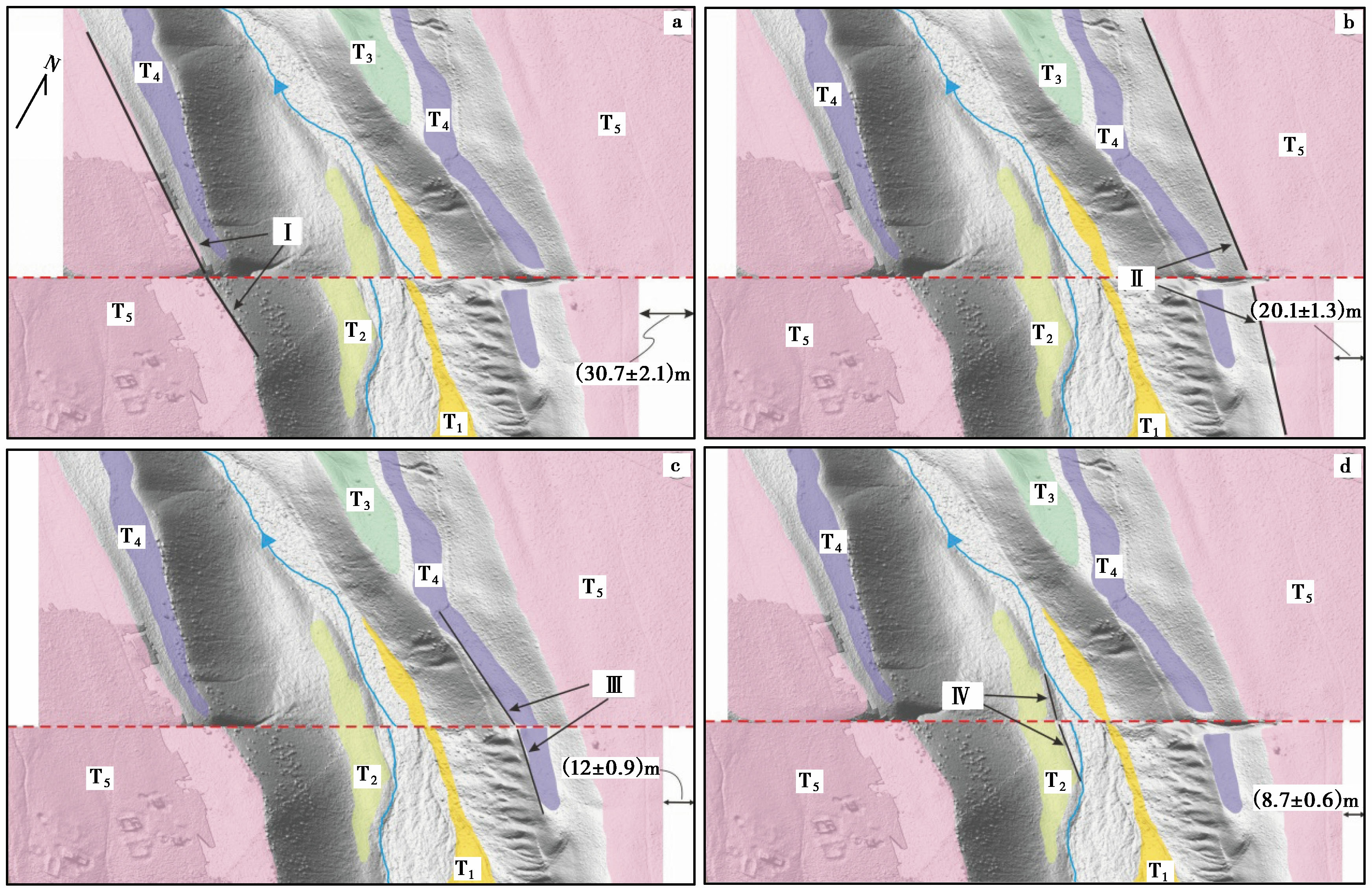
图 7 阿合别斗河断错阶地恢复与重建及左旋走滑位移量
Fig. 7 Restoration and reconstruction of the offset terraces of the Ahebiedou River and the left-lateral strike-slip displacements.
表2 冬别列克断裂各级阶地参数及滑动速率
Table 2 Computation sheet for slip rate of each level terrace on the Dongbielieke Fault

阶地编号最大拔河高度/m位错量/m年龄/ka滑动速率/mm·a-1水平(左旋)垂直(逆冲)水平(左旋)垂直(逆冲)T5(西岸)2730.7±2.14.9±0.444.85±4.30.7±0.110.11±0.02T5(东岸)20.1±1.30.46±0.08T41512±0.93.7±0.313.77±1.60.89±0.170.27±0.05T238.7±0.62.5±0.29.5±1.350.94±0.20.27±0.06T11~22.7±0.2
利用差分GPS测量得到阿合别斗河T5、 T4和T2阶地的垂直位错量分别为(4.9±0.4)m、 (3.7±0.3)m和(2.5±0.2)m(图4b), 结合地貌面年龄, 计算得到T5、 T4和T2阶地断层的抬升速率分别为(0.11±0.02)mm/a、 (0.27±0.05)mm/a和(0.27±0.06)mm/a。
3 讨论3.1 冬别列克断裂晚第四纪以来的滑动速率
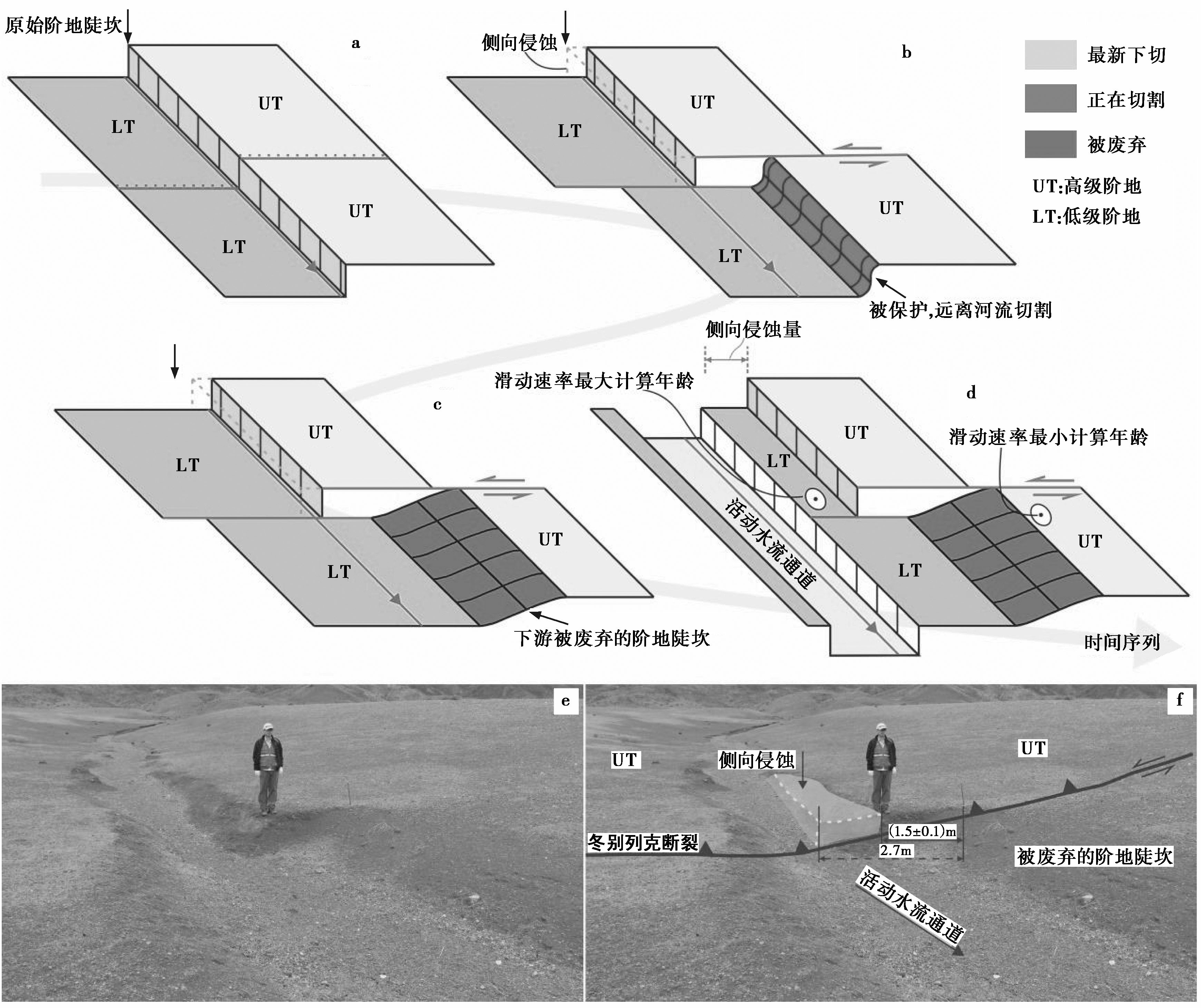
图 8 走滑断裂作用下河流阶地陡坎演化模式(改自Gold et al., 2009)
Fig. 8 The evolution model of river terrace scarp under strike-slip faulting(adapted after Gold et al., 2009).
a 高级阶地形成, 河流发育于低级阶地; b 沿着断层的滑动使下游高级阶地远离河流, 该阶地免受河流的侧向侵蚀; c 断层的持续活动使下游高级阶地被废弃, 同时坡度开始变缓; d 河流继续下切, 形成了新一级阶地, 原本的高、 低级阶地均被废弃; e 被断层断错的地貌照片; f 被断层断错, 正在受到侧向侵蚀、 演化的冲沟
滑动速率为断层累积位移量与相应地貌面被废弃的时间之比, 但断层活动造成的累积位移的起始时间很难确定。 最初, 相关学者(Berryman, 1990; Bull, 1991; Me′riaux et al., 2004; Rihanna, 2005)认为低一级阶地的废弃年龄足够限制、 计算高一级阶地的滑动速率, Van等(2002)提出的阶地堆积和抬升下切的基本原理认为低一级阶地的年龄比高一级阶地更加接近断层累积走滑位移的真实年龄; 而张培震等(2008)认为对于侧蚀作用不强的季节性河流和冲沟, 高级阶地的废弃年龄更加接近断层活动、 阶地陡坎累积走滑位移的真实年龄, 而这一假设是基于高一级阶地陡坎被断错并开始累积走滑位移时, 低级阶地已经形成。 但是, 实际工作中很难确定阶地陡坎是何时开始累积位移的, 如果高、 低2级阶地的废弃年龄相差较小, 可用这2级阶地的废弃年龄同时限定断层的长期滑动速率, 由此可得到断层滑动速率的上、 下限值(Kirby et al., 2007)。 为了更好地解释冬别列克断裂阶地位错的变形模式, 结合Gold等(2009)提出的阿尔金断裂带阶地变形和滑动速率计算的一种模式(图8), 阶地陡坎可能连续发育, 但季节性河流的差异横向侵蚀作用导致被断错的阶地陡坎的年龄具有不确定性, 如未考虑此因素, 则可能得到错误的水平滑动速率。 我们利用高一级阶地(UT)被断错远离河流侵蚀一侧的废弃年龄和低一级阶地(LT)被侵蚀一侧的年龄, 作为计算UT阶地滑动速率的上、 下限年龄(图8d)。
冬别列克断裂阶地位错变形模式可用差异断错阶地陡坎的形态来解释。 原始状态时, 阶地处于水流的侵蚀作用下, 保持陡峭、 平直的阶地陡坎(图8a); 断层活动后, 上游高级阶地(UT)继续发生侧向侵蚀, 阶地陡坎依旧陡峭, 而下游的阶地被断错发生偏移, 远离河流的侵蚀作用, 阶地陡坎无法保持陡峭的自由面, 坡度逐渐变小(图8b); 断层继续活动, 河流继续侧向侵蚀, 高、 低级阶地均逐渐被废弃, 形成最新的河床(图8c, d), 因此利用2级阶地废弃年龄的上、 下限可以给出滑动速率的上、 下限。
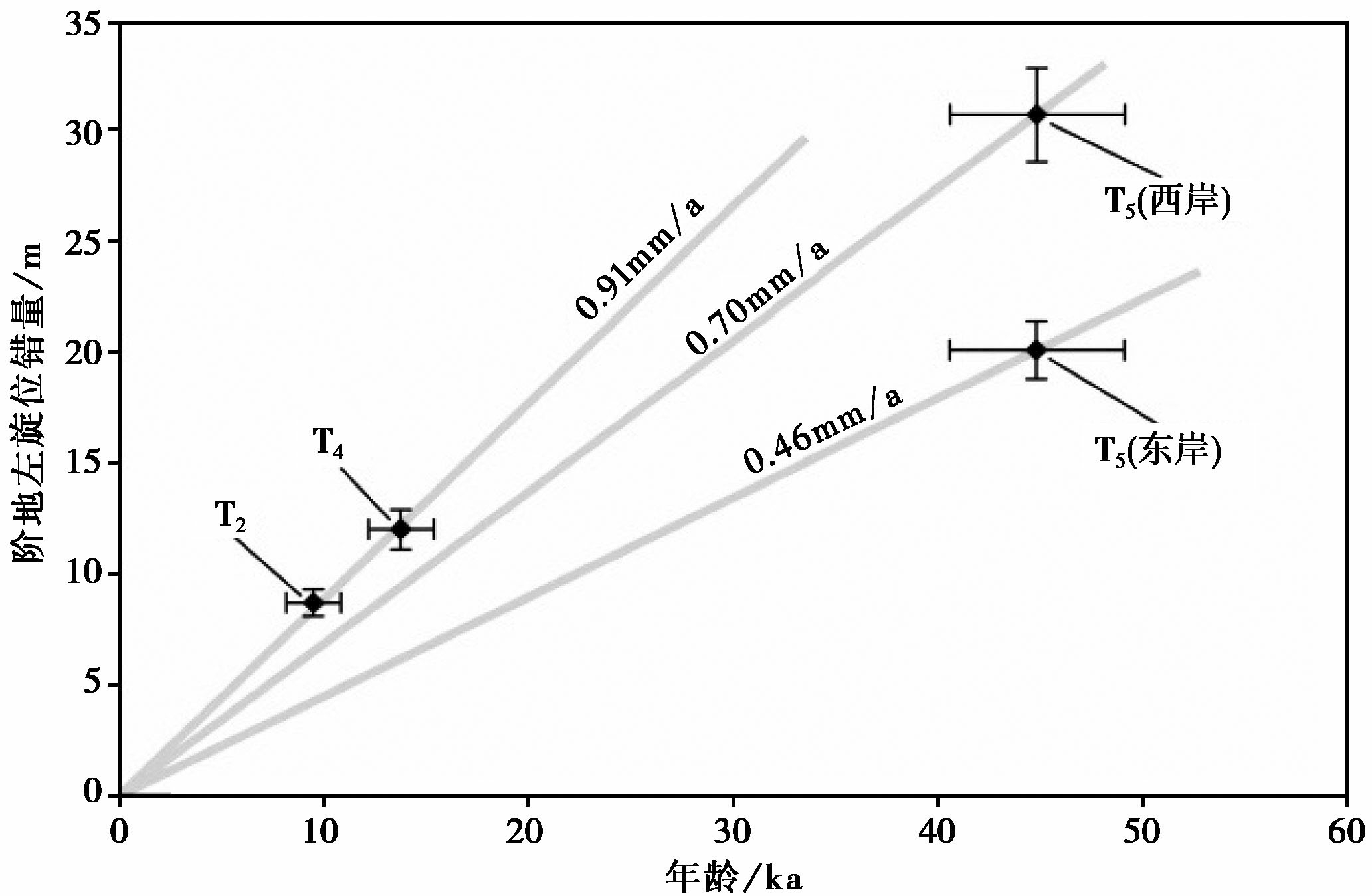
图 9 冬别列克断裂左旋位错和滑动速率
Fig. 9 Left-lateral displacement and slip rate of the Dongbielieke Fault.
在冬别列克断裂南段发现一处典型的河流阶地陡坎演化现象(图8e), 能够较好地对应所提出的模式, 即: 断层左旋断错冲沟和阶地陡坎, 断层下盘的左岸阶地陡坎被废弃、 保护, 坡度逐渐变小直至成为自然坡角; 而右岸被断错入河道的一侧受到水流的侵蚀, 依旧保持较陡的阶地陡坎。 上盘靠近断层处的阶地陡坎被侧向侵蚀(图8f), 恢复后的左旋位错量为2.7m, 大致是实测位错量的2倍, 这也是导致所得的走滑断裂的滑动速率偏小的原因之一(张培震等, 2008)。
冬别列克断裂位于塔城盆地东缘, 属于季节性降雨地区, 山前的主要河流同样为季节性河流(春、 夏季融雪, 降雨水量增大; 冬季降雪, 温度降低, 地表、 部分河床冻结), 河流的侧蚀作用较弱, 高一级阶地陡坎的位错量基本可以认为是该地貌面自形成以来所累积的位错量。
测量得到冬别列克断裂晚第四纪以来的左旋位错量(图9, 表2), 结合各地貌面的年龄结果(表1), 计算得到断裂T5阶地形成以来的各级位错量和滑动速率。 利用T5阶地西岸(30.7±2.1)m的最大位移和地貌面年龄得到的滑动速率为(0.7±0.11)mm/a; 同样, 用东岸的最小位移(20.1±1.3)m和地貌面年龄得到的滑动速率为(0.46±0.07)mm/a。 T5阶地在河流的两岸、 断层的两盘均有发育, 断层活动使阶地被断错后, 左岸下盘的阶地远离河流, 侵蚀作用基本停止, 此后河流主要切割东岸的阶地陡坎, 因此西岸保留着该地貌面更为准确的位移量(Gold et al., 2009), 故T5阶地的左旋滑动速率采用(0.7±0.11)mm/a(图9)。 计算得到的T4和T2阶地的左旋滑动速率比较相近, 取平均值为(0.91±0.18)mm/a(图9)。 河流阶地在演化过程中, 高级阶地的侧向侵蚀量要远大于低级阶地(图8d), 因此T4、 T2阶地的滑动速率更接近真实值, 由此可知冬别列克断裂晚第四纪以来的左旋滑动速率为(0.91±0.18)mm/a。
3.2 西准噶尔走滑型活动断裂在构造演化中的作用
本文通过对断错地貌面的恢复和其年龄的限定, 研究获得了西准噶尔地区NE-SW向的冬别列克左旋走滑断裂的活动速率和不同地貌面的位错量。 西准噶尔地区发育着3条近平行分布的左旋走滑断裂(冬别列克断裂、 托里断裂和达尔布特断裂), 综合对比这3条左旋走滑断裂系自晚第四纪以来的变形过程和滑动速率有助于进一步深入地理解该区域的地球动力学背景, 评估该区域的大地震危险性。 具体而言, Wu等(2018)发现达尔布特断裂的左旋活动开始于中二叠纪的265~268Ma BP; 宋彪等(2011)利用被托里断裂左旋断错的塔尔根岩体的年龄来限定托里断裂左旋走滑运动开始的最大时限, 认为走滑运动发生在295Ma BP之后(图10a); 目前缺少冬别列克断裂活动起始时间的证据, 但在断裂南端其断错了中石炭系的砂岩、 粉砂岩, 说明冬别列克断裂的活动时间在中石炭系(324Ma BP)之后。 因此, 以上3条断裂的起始活动时间近一致(石炭系—二叠系)。
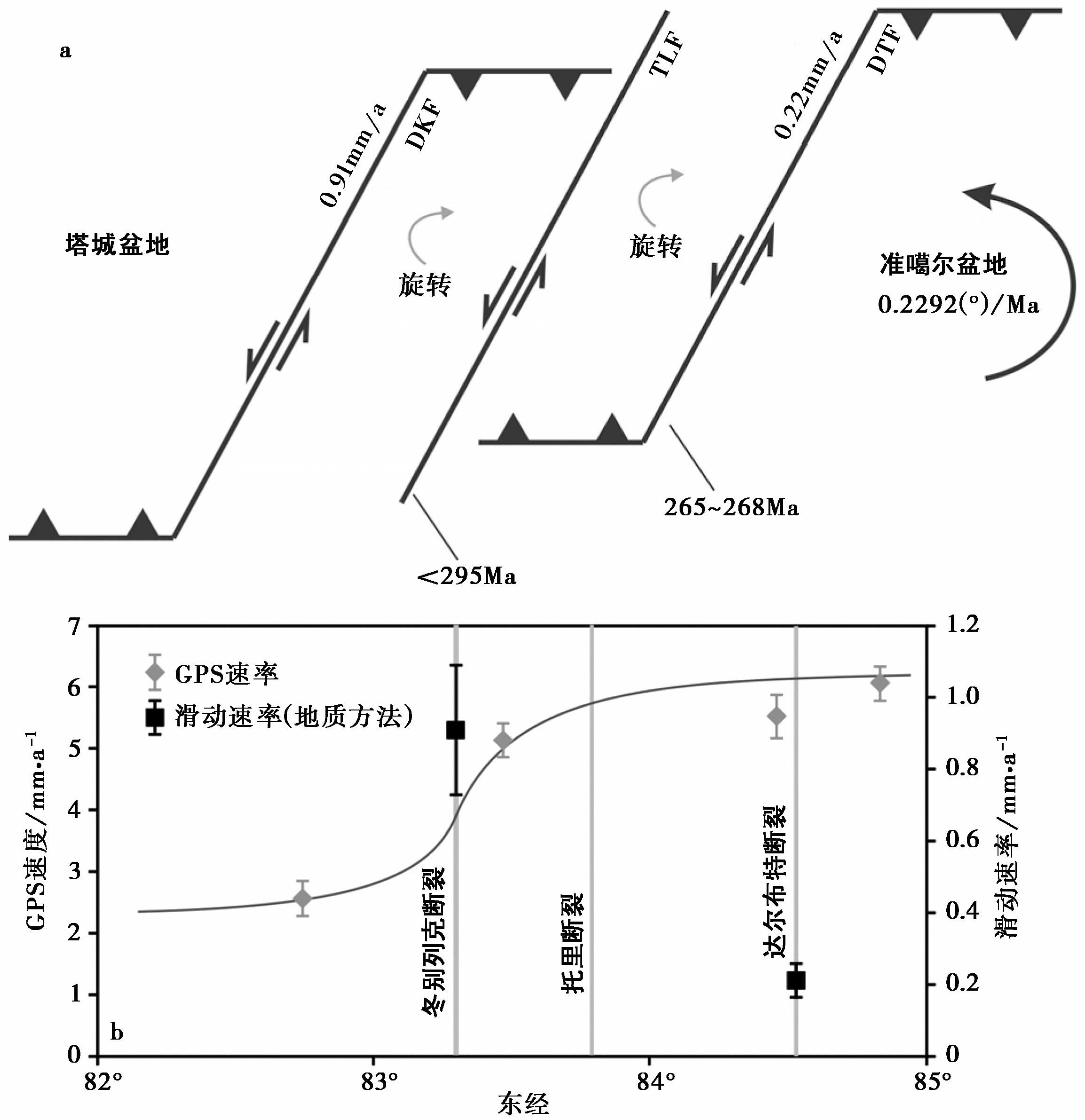
图 10 西准噶尔走滑型断裂的构造演化特征(a)、 GPS速率剖面和滑动速率对比数据(b)
Fig. 10 Characteristics of tectonic evolution(a), and comparison between GPS velocity profile and slip rate of the strike-slip faults in the western Junggar.
结合断层滑动速率及GPS观测数据(Wang et al., 2001; 李杰, 2012)所得的结果, 得到图10b所示的跨冬别列克断裂的运动变化特征。 结果显示, GPS速率在跨越冬别列克断裂后有明显的降低; 同时, 晚更新世以来达尔布特断裂的滑动速率为0.2~0.22mm/a(赵瑞斌等, 1997), 冬别列克断裂的滑动速率为0.91mm/a, 两者速度也呈现出较大的差异。 因此, 结合西准噶尔的其它2条大型走滑断裂(达尔布特断裂和托里断裂)的滑动速率, 并对比西准噶尔地区的GPS速率, 认为该地区NE向的走滑运动以冬别列克断裂为主, 其吸收了大量的剩余变形, 保持相对较高的左旋滑动速率。 综合目前的研究成果可以看出, 西准噶尔地区主要以NE走向的左旋走滑断裂为控制断裂, 但该地区自有历史记载以来从未发生过大型破坏性地震, 这一特征很可能是印度板块与欧亚板块相互作用在西准噶尔地区地壳处于低应变速率条件下的远程变形效应(徐锡伟等, 2012)。
4 总结
冬别列克断裂是塔城盆地与西准噶尔山地的分界断裂, 同时是西准噶尔地区三大NE-SW向大断裂之一, 断裂的总长度超过120km, 走向NE。 晚更新世以来冬别列克断裂具有较强的活动性, 其南段保留了清晰的断裂变形特征。 断裂切穿了阿合别斗河的多级阶地(T5—T1)。
利用高精度无人机影像与差分GPS描绘、 测量各级阶地上断裂的走滑位错量, 发现T5、 T4和T2阶地的最大左旋位错量依次为30.7m、 12.0m和8.7m。 此外, 根据光释光测年获得地貌面的年龄, 对冬别列克断裂不同阶地的滑动速率进行了限定, 得到冬别列克断裂晚第四纪以来的平均左旋走滑速率为(0.91±0.18)mm/a。 结合西准噶尔地区的GPS速率, 分析认为冬别列克、 托里及达尔布特这3条大型NE向的走滑断裂以冬别列克断裂的活动为主, 其吸收了大量的剩余变形, 同时保持相对较高的左旋滑动速率。 同样, 在印度板块与欧亚板块的相互作用下, 西准噶尔地区呈现低应变速率条件下的远程变形特征, 未来具有发生强震的危险性。
致谢 陈杰研究员对于年代数据给予了重要的意见; 李涛博士对本文的原始数据进行了分析, 并进行了有益的讨论; 审稿专家对本文提出了宝贵的意见和建议, 使文章内容更为完善。 在此一并表示感谢!
柏美祥. 1996. 额尔齐斯活动断裂带 [J]. 新疆地质, 14(2): 127—134.
BAI Mai-xiang. 1996. Ertix active fault zone [J]. Xinjiang Geology, 14(2): 127—134(in Chinese).
邓起东, 冯先岳, 张培震, 等. 1999. 乌鲁木齐山前坳陷逆断裂-褶皱带及其形成机制 [J]. 地学前缘, 6(4): 191—201.
DENG Qi-dong, FENG Xian-yue, ZHANG Pei-zhen, et al. 1999. Reverse fault and fold zone in the Urumqi range-front depression of the northern Tianshan and its genetic mechanism [J]. Earth Science Frontiers, 6(4): 191—201(in Chinese).
冯先岳. 1985. 论新疆地震地质特征 [J]. 地震地质, 7(2): 35— 44.
FENG Xian-yue. 1985. Seismogeological characteristics of the Xinjiang area [J]. Seismology and Geology, 7(2): 35— 44(in Chinese).
郭召杰, 陈正乐, 舒良树, 等. 2006. 中国西部中亚型造山带中新生代陆内造山过程与砂岩型铀矿成矿作用 [M]. 北京: 地质出版社.
GUO Zhao-jie, CHEN Zheng-le, SHU Liang-shu, et al. 2006. Meso-Cenozoic Intracontinental Orogenic Process and Sandstone-type Uranium Mineralization in Central Asia Orogenic Belt in Western China [M]. Geological Publishing House, Beijing(in Chinese).
李杰. 2012. 天山及邻区现今地震构造环境与强震危险性的GPS研究 [D]. 武汉: 中国地质大学.
LI Jie. 2012. Kinematics of present-day deformation of the Tien Shan and adjacent regions with GPS geodesy: Implications for active tectonics and seismic hazards [D]. Chinese University of Geosciences, Wuhan(in Chinese).
李锦轶, 何国琦, 徐新, 等. 2006. 新疆北部及邻区地壳构造格架及其形成过程的初步探讨 [J]. 地质学报, 80(1): 148—168.
LI Jin-yi, HE Guo-qi, XU Xin, et al. 2006. Crustal tectonic framework of northern Xinjiang and adjacent regions and its formation [J]. Acta Geologica Sinica, 80(1): 148—168(in Chinese).
罗福忠, 姚远, 唐丽华, 等. 2015. 新疆塔城盆地断裂的晚第四纪活动特征 [J]. 内陆地震, 29(3): 195—202.
LUO Fu-zhong, YAO Yuan, TANG Li-hua, et al. 2015. Characteristics of late Quaternary faults in Tacheng Basin, Xinjiang [J]. Inland Earthquake, 29(3): 195—202(in Chinese).
曲国胜, 马宗晋, 邵学钟, 等. 2008a. 准噶尔盆地基底构造与地壳分层结构 [J]. 新疆石油地质, 29(6): 669— 674.
QU Guo-sheng, MA Zong-jin, SHAO Xue-zhong, et al. 2008a. Basements and crust structures in Junggar Basin [J]. Xinjiang Petroleum Geology, 29(6): 669— 674(in Chinese).
曲国胜, 马宗晋, 张宁, 等. 2008b. 准噶尔盆地及周缘断裂构造特征 [J]. 新疆石油地质, 29(3): 290—295.
QU Guo-sheng, MA Zong-jin, ZHANG Ning, et al. 2008b. Fault structures in and around Junggar Basin [J]. Xinjiang Petroleum Geology, 29(3): 290—295(in Chinese).
宋彪, 李锦轶, 张进, 等. 2011. 西准噶尔托里地区塔尔根二长花岗岩锆石U-Pb年龄: 托里断裂左行走滑运动开始的时间约束 [J]. 地质通报, 30(1): 19—25.
SONG Biao, LI Jin-yi, ZHANG Jin, et al. 2011. Zircon SHRIMP U-Pb age of Targen monzogranite in western Junggar, Xinjiang, China: Initial time of left-lateral slip of the Tuoli Fault [J]. Geological Bulletin of China, 30(1): 19—25.
肖文交, 舒良树, 高俊, 等. 2008. 中亚造山带大陆动力学过程与成矿作用 [J]. 新疆地质, 26(1): 4—8.
XIAO Wen-jiao, SHU Liang-shu, GAO Jun, et al. 2008. Continental dynamics of the central Asian orogenic belt and its metallogeny [J]. Xinjiang Geology, 26(1): 4—8(in Chinese).
徐锡伟, 孙鑫喆, 谭锡斌, 等. 2012. 富蕴断裂: 低应变速率条件下断层滑动习性 [J]. 地震地质, 34(4): 606— 617. doi: 10.3969/j.issn.0253-4967.2012.04.007.
XU Xi-wei, SUN Xin-zhe, TAN Xi-bin, et al. 2012. Fuyun Fault: Long-term faulting behavior under low crustal strain rate [J]. Seismology and Geology, 34(4): 606— 617(in Chinese).
新疆维吾尔自治区地震局. 1985. 富蕴地震断裂带 [M]. 北京: 地震出版社.
Seismological Bureau of Xinjiang Uygur Autonomous Region. 1985. The Fuyun Earthquake Fault Zone in Xinjiang, China [M]. Seismological Press, Beijing(in Chinese).
杨庚, 王晓波, 李本亮, 等. 2011. 准噶尔西北缘斜向挤压构造与走滑断裂 [J]. 地质科学, 46(3): 696—708.
YANG Geng, WANG Xiao-bo, LI Ben-liang, et al. 2011. Transpression and wrench faults of northwestern margin of Junggar Basin [J]. Chinese Journal of Geology, 46(3): 696—708(in Chinese).
杨晓平, 邓起东, 张培震, 等. 1998. 北天山地区活动逆断裂-褶皱带构造与潜在震源区估计 [J]. 地震地质, 20(3): 193—200.
YANG Xiao-ping, DENG Qi-dong, ZHANG Pei-zhen, et al. 1998. Active reverse fault-fold zones and estimation of potential earthquake sources in northern Tianshan [J]. Seismology and Geology, 20(3): 193—200(in Chinese).
杨晓平, 邓起东, 张培震, 等. 2008. 天山山前主要推覆构造区的地壳缩短 [J]. 地震地质, 30(1): 111—131.
YANG Xiao-ping, DENG Qi-dong, ZHANG Pei-zhen, et al. 2008. Crustal shortening of major nappe structures on the front margins of the Tianshan [J]. Seismology and Geology, 30(1): 111—131(in Chinese).
姚远, 吴传勇, 罗福忠. 2015. 新疆塔城盆地东缘冬别列克断裂晚第四纪活动特征 [J]. 内陆地震, 29(1): 71—76.
YAO Yuan, WU Chuan-yong, LUO Fu-zhong. 2015. Characteristics of late Quaternary activity on Dongbielieke fracture located eastern margin of Tacheng Basin in Xinjiang [J]. Inland Earthquake, 29(1): 71—76(in Chinese).
张培震, 李传友, 毛凤英. 2008. 河流阶地演化与走滑断裂滑动速率 [J]. 地震地质, 30(1): 44—57.
ZHANG Pei-zhen, LI Chuan-you, MAO Feng-ying. 2008. Strath terrace formation and strike-slip faulting [J]. Seismology and Geology, 30(1): 44—57(in Chinese).
赵瑞斌, 李进云, 石树中, 等. 1997. 达尔布特断裂中段构造活动性 [J]. 内陆地震, 11(4): 295—301.
ZHAO Rui-bin, LI Jin-yun, SHI Shu-zhong, et al. 1997. Structural activity of middle Daerbute Fault [J]. Inland Earthquake, 11(4): 295—301(in Chinese).
Allen M B, Stephen J V. 1997. Fault reactivation in the Junggar region, Northwest China: The role of basement structures during Mesozoic-Cenozoic compression [J]. Journal of the Geological Society, 154(1): 151—155.
Avouac J P, Tapponnier P. 1993. Kinematic model of active deformation in Central Asia [J]. Geophysical Research Letters, 20(10): 895—898. doi:10.1029/93GL00128.
Berryman K. 1990. Late Quaternary movement on the Wellington Fault in the Upper Hutt area, New Zealand [J]. New Zealand Journal of Geology and Geophysics, 33(2): 257—270.
Bull W B. 1991. Geomorphic Responses to Climatic Change [M]. Oxford University Press, New York.
Burchfiel B C, Deng Q D, Molnar P, et al. 1989. Intracrustal detachment zones of continental deformation [J]. Geology, 17(8): 748—752.
Cowgill E. 2007. Impact of riser reconstructions on estimation of secular variation in rates of strike-slip faulting: Revisiting the Cherchen River site along the Altyn Tagh Fault, NW China [J]. Earth and Planetary Science Letters, 254(3-4): 239—255. doi:10.1016/j.epsl.2006.09.015.
England P, Molnar P. 2005. Late Quaternary to decadal velocity fields in Asia [J]. Journal of Geophysical Researcher, 110(B12): B12401. doi∶10.1029/2004JB003541.
Gold R D, Cowgill E, Arrowsmith J R, et al. 2009. Riser diachroneity, lateral erosion, and uncertainty in rates of strike-slip faulting: A case study from Tuzidun along the Altyn Tagh Fault, NW China [J]. Journal of Geophysical Research: Solid Earth, 114(B4): B04401.
Harkins N, Kirby E. 2008. Fluvial terrace riser degradation and determination of slip rates on strike-slip faults: An example from the Kunlun Fault, China [J]. Geophysical Research Letters, 35(5): L05406. doi∶10.1029/2007GL033073.
Kirby E, Harkins N, Wang E, et al. 2007. Slip rate gradients along the eastern Kunlun Fault [J]. Tectonics, 26(2): TC2010.doi∶10.1029/2006TC002033.
Lensen G J. 1968. Analysis of progressive fault displacement during downcutting at the Branch River terraces, South Island, New Zealand [J]. Geological Society of America Bulletin, 79(5): 545—556.
Lin A, Lin S J. 1998. Tree damage and surface displacement: The 1931 M8.0 Fuyun earthquake [J]. Journal of Geology, 106(6): 751—758.
Me′riaux A S, Ryerson F J, Tapponnier P, et al. 2004. Rapid slip along the central Altyn Tagh Fault: Morphochronologic evidence from Cherchen He and Sulamu Tagh [J]. Journal of Geophysical Research, 109(B6): B06401. doi∶10.1029/2003jb002558.
Molnar P, Tapponnier P. 1975. Cenozoic tectonics of Asia: Effects of a continental collision [J]. Science, 189(4201): 419— 426.
Peltzer G, Tapponnier P. 1988. Formation and evolution of strike-slip faults, rifts, and basins during the India-Asia collision; an experimental approach [J]. Journal of Geophysical Research: Solid Earth, 93(B12): 15085—15117. doi∶10.102 9/JB093iB12p15085.
Peltzer G, Tapponnier P, Armijo R. 1989. Magnitude of Late Quaternary left-lateral displacements along the north edge of Tibet [J]. Science, 246(4935): 1285—1289.
Prentice C S, Carol S. 2003. Slip rate and earthquake recurrence along the central Septentrional fault, North American-Caribbean plate boundary, Dominican Republic [J]. Journal of Geophysical Research: Solid Earth, 108(B3): 2149. doi∶10.1029/2001JB000442.
Replumaz A, Tapponnier P. 2003. Reconstruction of the deformed collision zone between India and Asia by backward motion of lithospheric blocks [J]. Journal of Geophysical Research: Solid Earth, 108(B6): 2285. doi∶10.1029/2001JB000661.
Mériaux A S, Tapponnier R, Ryerson F J, et al. 2005. The Aksay segment of the northern Altyn Tagh Fault: Tectonic geomorphology, landscape evolution, and Holocene slip rate [J]. Journal of Geophysical Research: Solid Earth, 110(B4): 229—246.
Sieh K. 1996. The repetition of large-earthquake ruptures [J]. Proceedings of the National Academy of Sciences of the United States of America, 93(9): 3764—3771.
Tapponnier P, Peltzer G, Le D, et al. 1982. Propagating extrusion tectonics in Asia: New insights from experiments with plasticine [J]. Geology, 10(12): 611— 616.
Tapponnier P, Xu Z Q, Roger F, et al. 2001. Oblique stepwise rise and growth of the Tibet Plateau [J]. Science, 294(5574): 1671—1677.
Van D W J, Ryerson F J, Tapponnier P, et al. 1998. Holocene left-slip rate determined by cosmogenic surface dating on the Xidatan segment of the Kunlun Fault(Qinghai, China)[J]. Geology, 26(8): 695— 698.
Van D W J, Tapponnier P, Ryerson F J, et al. 2002. Uniform postglacial slip-rate along the central 600km of the Kunlun Fault(Tibet), from26Al, 10Be and14C dating of riser offsets, and climatic origin of the regional morphology [J]. Geophysical Journal international, 148(3): 356—388.
Wang Q, Zhang P Z, Freymueller J T, et al. 2001. Present-day crustal deformation in China constrained by Global Positioning System measurements [J]. Science, 294(5542): 574—577.
Weldon R J, Sieh K E. 1985. Holocene rate of slip and tentative recurrence interval for large earthquakes on the San Andreas Fault, Cajon Pass, Southern California [J]. Geological Society of America Bulletin, 96(6): 793.
Wu K Y, Pei Y W, Li T R, et al. 2018. Structural characteristics and implication on tectonic evolution of the Daerbute strike-slip fault in West Junggar area, NW China [J]. Frontiers of Earth Science, 12(3): 555—568.
Yin A, Nie S, Craig P, et al. 1998. Late Cenozoic tectonic evolution of southern Chinese Tianshan [J]. Tectonics, 17(1): 1—27.
Zielke S, Bodnar A. 2010. Telomeres and telomerase activity in scleractinian corals and Symbiodinium spp [J]. Biological Bulletin, 218(2): 113—121.
TERRACE DEFORMATION AND SLIP RATES OF THE DONGBIELIEKE FAULT IN WESTERN JUNGGAR BASIN SINCE THE LATE QUATERNARY
Strike-slip fault plays an important role in the process of tectonic deformation since Cenozoic in Asia. The role of strike-slip fault in the process of mountain building and continental deformation has always been an important issue of universal concern to the earth science community. Junggar Basin is located in the hinterland of Central Asia, bordering on the north the Altay region and the Baikal rift system, which are prone to devastating earthquakes, the Tianshan orogenic belt and the Tibet Plateau on the south, and the rigid blocks, such as Erdos, the South China, the North China Plain and Amur, on the east. Affected by the effect of the Indian-Eurasian collision on the south of the basin and at the same time, driven by the southward push of the Mongolian-Siberian plate, the active structures in the periphery of the basin show a relatively strong activity. The main deformation patterns are represented by the large-scale NNW-trending right-lateral strike-slip faults dominated by right-lateral shearing, the NNE-trending left-lateral strike-slip faults dominated by left-lateral shearing, and the thrust-nappe structure systems distributed in piedmont of Tianshan in the south of the basin. There are three near-parallel-distributed left-lateral strike-slip faults in the west edge of the basin, from the east to the west, they are: the Daerbute Fault, the Toli Fault and the Dongbielieke Fault. This paper focuses on the Dongbielieke Fault in the western Junggar region. The Dongbielieke Fault is a Holocene active fault, located at the key position of the western Junggar orogenic belt. The total length of the fault is 120km, striking NE. Since the late Quaternary, the continuous activity of the Dongbielieke Fault has caused obvious left-lateral displacement at all geomorphologic units along the fault, and a linear continuous straight steep scarp was formed on the eastern side of the Tacheng Basin. According to the strike and the movement of fault, the fault can be divided into three segments, namely, the north, middle and south segment.
In order to obtain a more accurate magnitude of the left-lateral strike-slip displacement and the accumulative left-lateral strike-slip displacement of different geomorphic surfaces, we chose the Ahebiedou River in the southern segment and used the UAV to take three-dimensional photographs to obtain the digital elevation model(the accuracy is 10cm). And on this basis, the amount of left-lateral strike-slip displacement of various geological masses and geomorphic surfaces(lines)since their formation is obtained. The maximum left-lateral displacement of the terrace T5 is(30.7±2.1)m and the minimum left-lateral displacement is(20.1±1.3)m; the left-lateral displacement of the terrace T4 is(12±0.9)m, and the left-lateral displacement of the terrace T2 is(8.7±0.6)m. OSL dating samples from the surface of different level terraces(T5, T4, T2 and T1)are collected, processed and measured, and the ages of the terraces of various levels are obtained. By measuring the amount of left-lateral displacements since the Late Quaternary of the Dongbielieke Fault and combining the dating results of the various geomorphic surfaces, the displacements and slip rates of the fault on each level of the terraces since the formation of the T5 terrace are calculated. Using the maximum displacement of(30.7±2.1)m of the T5 terrace and the age of the geomorphic surface on the west bank of the river, we obtained the slip rate of(0.7±0.11)mm/a; similarly, using the minimum displacement of(20.1±1.3)m and the age of the geomorphic surface of the east bank, we obtained the slip rate of(0.46±0.07)mm/a. T5 terrace is developed on both banks of the river and on both walls of the fault. After the terraces are offset by faulting, the terraces on foot wall in the left bank of the river are far away from the river, and the erosion basically stops. After that, the river mainly cuts the terraces on the east bank. Therefore, the west bank retains a more accurate displacement of the geomorphic surface(Gold et al., 2009), so the left-lateral slip rate of the T5 terrace is taken as(0.7±0.11)mm/a. The left-lateral slip rate calculated for T4 and T2 terraces is similar, with an average value of(0.91±0.18)mm/a. In the evolution process of river terraces, the lateral erosion of high-level terrace is much larger than that of low-level terrace, so the slip rate of T4 and T2 terraces is closer to the true value. The left-lateral slip rate of the Dongbielieke Fault since the late Quaternary is(0.91±0.18)m/a. Compared with the GPS slip rate in the western Junggar area, it is considered that the NE-trending strike-slip motion in this area is dominated by the Dongbielieke Fault, which absorbs a large amount of residual deformation while maintaining a relatively high left-lateral slip rate.
